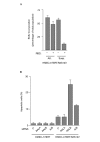RAL GTPases are linchpin modulators of human tumour-cell proliferation and survival
- PMID: 12856001
- PMCID: PMC1326339
- DOI: 10.1038/sj.embor.embor899
RAL GTPases are linchpin modulators of human tumour-cell proliferation and survival
Abstract
The monomeric RAL (RAS-like) GTPases have been indirectly implicated in mitogenic regulation and cell transformation. Here, we show that RALA and RALB collaborate to maintain tumorigenicity through regulation of both proliferation and survival. Remarkably, this task is divided between these highly homologous isoforms. RALB is specifically required for survival of tumour cells but not normal cells. RALA is dispensable for survival, but is required for anchorage-independent proliferation. Reducing the 'oncogenic burden' in human tumour cells relieves the sensitivity to loss of RALB. These observations establish RAL GTPases as crucial components of the cellular machinery that are exploited by factors that drive oncogenic transformation.
Figures





References
-
- Chardin P. ( 1988) The ras superfamily proteins. Biochimie, 70, 865–868. - PubMed
-
- Elbashir S.M., Harborth J., Lendeckel W., Yalcin A., Weber K. & Tuschl T. ( 2001) Duplexes of 21-nucleotide RNAs mediate RNA interference in cultured mammalian cells. Nature, 411, 494–498. - PubMed
-
- Evan G. & Littlewood T. ( 1998) A matter of life and cell death. Science, 281, 1317–1322. - PubMed
Publication types
MeSH terms
Substances
Grants and funding
LinkOut - more resources
Full Text Sources
Other Literature Sources

